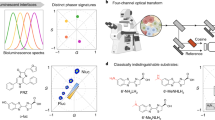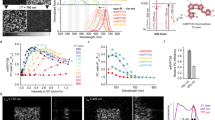Abstract
In principle, the millisecond emission lifetimes of lanthanide chelates should enable their ultrasensitive detection in biological systems by time-resolved optical microscopy. In practice, however, lanthanide imaging techniques have provided no better sensitivity than conventional fluorescence microscopy. Here, we identified three fundamental problems that have impeded lanthanide microscopy: low photon flux, inefficient excitation, and optics-derived background luminescence. We overcame these limitations with a new lanthanide imaging modality, transreflected illumination with luminescence resonance energy transfer (trLRET), which increases the time-integrated signal intensities of lanthanide lumiphores by 170-fold and the signal-to-background ratios by 75-fold. We demonstrate that trLRET provides at least an order-of-magnitude increase in detection sensitivity over that of conventional epifluorescence microscopy when used to visualize endogenous protein expression in zebrafish embryos. We also show that trLRET can be used to optically detect molecular interactions in vivo. trLRET promises to unlock the full potential of lanthanide lumiphores for ultrasensitive, autofluorescence-free biological imaging.
This is a preview of subscription content, access via your institution
Access options
Access Nature and 54 other Nature Portfolio journals
Get Nature+, our best-value online-access subscription
$29.99 / 30 days
cancel any time
Subscribe to this journal
Receive 12 print issues and online access
$259.00 per year
only $21.58 per issue
Buy this article
- Purchase on Springer Link
- Instant access to full article PDF
Prices may be subject to local taxes which are calculated during checkout






Similar content being viewed by others
References
Grimm, J.B., Heckman, L.M. & Lavis, L.D. The chemistry of small-molecule fluorogenic probes. Prog. Mol. Biol. Transl. Sci. 113, 1–34 (2013).
Rodriguez, E.A. et al. The growing and glowing toolbox of fluorescent and photoactive proteins. Trends Biochem. Sci. 42, 111–129 (2017).
Shu, X. et al. Mammalian expression of infrared fluorescent proteins engineered from a bacterial phytochrome. Science 324, 804–807 (2009).
Shcherbakova, D.M. & Verkhusha, V.V. Near-infrared fluorescent proteins for multicolor in vivo imaging. Nat. Methods 10, 751–754 (2013).
Bertrand, E. et al. Localization of ASH1 mRNA particles in living yeast. Mol. Cell 2, 437–445 (1998).
Raj, A., van den Bogaard, P., Rifkin, S.A., van Oudenaarden, A. & Tyagi, S. Imaging individual mRNA molecules using multiple singly labeled probes. Nat. Methods 5, 877–879 (2008).
Choi, H.M.T. et al. Programmable in situ amplification for multiplexed imaging of mRNA expression. Nat. Biotechnol. 28, 1208–1212 (2010).
Tanenbaum, M.E., Gilbert, L.A., Qi, L.S., Weissman, J.S. & Vale, R.D. A protein-tagging system for signal amplification in gene expression and fluorescence imaging. Cell 159, 635–646 (2014).
Connally, R.E. & Piper, J.A. Time-gated luminescence microscopy. Ann. NY Acad. Sci. 1130, 106–116 (2008).
Jin, D. et al. How to build a time-gated luminescence microscope. Curr. Protoc. Cytom. 67, 2.22 (2014).
Beverloo, H.B., van Schadewijk, A., van Gelderen-Boele, S. & Tanke, H.J. Inorganic phosphors as new luminescent labels for immunocytochemistry and time-resolved microscopy. Cytometry 11, 784–792 (1990).
Marriott, G., Clegg, R.M., Arndt-Jovin, D.J. & Jovin, T.M. Time resolved imaging microscopy: phosphorescence and delayed fluorescence imaging. Biophys. J. 60, 1374–1387 (1991).
Seveus, L. et al. Time-resolved fluorescence imaging of europium chelate label in immunohistochemistry and in situ hybridization. Cytometry 13, 329–338 (1992).
Marriott, G., Heidecker, M., Diamandis, E.P. & Yan-Marriott, Y. Time-resolved delayed luminescence image microscopy using an europium ion chelate complex. Biophys. J. 67, 957–965 (1994).
Moore, E.G., Jocher, C.J., Xu, J., Werner, E.J. & Raymond, K.N. An octadentate luminescent Eu(III) 1,2-HOPO chelate with potent aqueous stability. Inorg. Chem. 46, 5468–5470 (2007).
Montgomery, C.P., Murray, B.S., New, E.J., Pal, R. & Parker, D. Cell-penetrating metal complex optical probes: targeted and responsive systems based on lanthanide luminescence. Acc. Chem. Res. 42, 925–937 (2009).
Bünzli, J.-C.G. Lanthanide luminescence for biomedical analyses and imaging. Chem. Rev. 110, 2729–2755 (2010).
Xu, J. et al. Octadentate cages of Tb(III) 2-hydroxyisophthalamides: a new standard for luminescent lanthanide labels. J. Am. Chem. Soc. 133, 19900–19910 (2011).
Heffern, M.C., Matosziuk, L.M. & Meade, T.J. Lanthanide probes for bioresponsive imaging. Chem. Rev. 114, 4496–4539 (2014).
Dickson, E.F., Pollak, A. & Diamandis, E.P. Ultrasensitive bioanalytical assays using time-resolved fluorescence detection. Pharmacol. Ther. 66, 207–235 (1995).
Hagan, A.K. & Zuchner, T. Lanthanide-based time-resolved luminescence immunoassays. Anal. Bioanal. Chem. 400, 2847–2864 (2011).
Emami-Nemini, A. et al. Time-resolved fluorescence ligand binding for G protein-coupled receptors. Nat. Protoc. 8, 1307–1320 (2013).
Connally, R., Jin, D. & Piper, J. High intensity solid-state UV source for time-gated luminescence microscopy. Cytometry A 69, 1020–1027 (2006).
Gahlaut, N. & Miller, L.W. Time-resolved microscopy for imaging lanthanide luminescence in living cells. Cytometry A 77, 1113–1125 (2010).
Rajendran, M. & Miller, L.W. Evaluating the performance of time-gated live-cell microscopy with lanthanide probes. Biophys. J. 109, 240–248 (2015).
Moore, E.G., Samuel, A.P. & Raymond, K.N. From antenna to assay: lessons learned in lanthanide luminescence. Acc. Chem. Res. 42, 542–552 (2009).
Bünzli, J.C. & Piguet, C. Taking advantage of luminescent lanthanide ions. Chem. Soc. Rev. 34, 1048–1077 (2005).
Armelao, L. et al. Design of luminescent lanthanide complexes: from molecules to highly efficient photo-emitting materials. Coord. Chem. Rev. 254, 487–505 (2010).
Mathis, G. & Bazin, H. in Lanthanide Luminescence 47–88 (Springer, 2011).
Byegård, J., Skarnemark, G. & Skålberg, M. The stability of some metal edta, dtpa and dota complexes: application as tracers in groundwater studies. J. Radioanal. Nucl. Chem. 241, 281–290 (1999).
Firsching, F.H. & Brune, S.N. Solubility products of the trivalent rare-earth phosphates. J. Chem. Eng. Data 36, 93–95 (1991).
Chen, J. & Selvin, P.R. Synthesis of 7-amino-4-trifluoromethyl-2-(1H)-quinolinone and its use as an antenna molecule for luminescent europium polyaminocarboxylates chelates. J. Photochem. Photobiol. Chem. 135, 27–32 (2000).
Nishioka, T. et al. New luminescent europium(III) chelates for DNA labeling. Inorg. Chem. 45, 4088–4096 (2006).
Hanaoka, K., Kikuchi, K., Kobayashi, S. & Nagano, T. Time-resolved long-lived luminescence imaging method employing luminescent lanthanide probes with a new microscopy system. J. Am. Chem. Soc. 129, 13502–13509 (2007).
Thomas, D.D., Carlsen, W.F. & Stryer, L. Fluorescence energy transfer in the rapid-diffusion limit. Proc. Natl. Acad. Sci. USA 75, 5746–5750 (1978).
Rajapakse, H.E. et al. Time-resolved luminescence resonance energy transfer imaging of protein-protein interactions in living cells. Proc. Natl. Acad. Sci. USA 107, 13582–13587 (2010).
Yam, V.W. & Wong, K.M. Luminescent metal complexes of d6, d8 and d10 transition metal centres. Chem. Commun. (Camb.) 47, 11579–11592 (2011).
Thorp-Greenwood, F.L., Balasingham, R.G. & Coogan, M.P. Organometallic complexes of transition metals in luminescent cell imaging applications. J. Organomet. Chem. 714, 12–21 (2012).
Botchway, S.W. et al. Time-resolved and two-photon emission imaging microscopy of live cells with inert platinum complexes. Proc. Natl. Acad. Sci. USA 105, 16071–16076 (2008).
de Haas, R.R. et al. Phosphorescent platinum/palladium coproporphyrins for time-resolved luminescence microscopy. J. Histochem. Cytochem. 47, 183–196 (1999).
Selvin, P.R. Lanthanide-based resonance energy transfer. IEEE J. Sel. Top. Quantum Electron. 2, 1077–1087 (1996).
Kubota, T. et al. Mapping of voltage sensor positions in resting and inactivated mammalian sodium channels by LRET. Proc. Natl. Acad. Sci. USA 114, E1857–E1865 (2017).
Norris, K.P., Seeds, W.E. & Wilkins, M.H.F. Reflecting microscopes with spherical mirrors. J. Opt. Soc. Am. 41, 111–119 (1951).
Miyata, S., Yanagawa, S. & Noma, M. Reflecting microscope objectives with nonspherical mirrors. J. Opt. Soc. Am. 42, 431–432 (1952).
Witlin, B. Darkfield illuminators in microscopy. Science 102, 41–42 (1945).
Huisken, J., Swoger, J., Del Bene, F., Wittbrodt, J. & Stelzer, E.H. Optical sectioning deep inside live embryos by selective plane illumination microscopy. Science 305, 1007–1009 (2004).
Lu, Y. et al. Tunable lifetime multiplexing using luminescent nanocrystals. Nat. Photonics 8, 32–36 (2014).
Chen, J.Y. & Selvin, P.R. Lifetime- and color-tailored fluorophores in the micro- to millisecond time regime. J. Am. Chem. Soc. 122, 657–660 (2000).
Acknowledgements
This paper is dedicated to the memory of M. Buchin, whose technical expertise was invaluable for this project. We also thank D. Callard and J. Stepkowski (Stanford Photonics) for their assistance with our ICCD camera, C. Limouse for discussions about optical design and alignment, and D. Fitzpatrick and G. Gatmaitan (IOS Optics) for the design and fabrication of TiO2-coated coverglasses. This work was supported by a Samsung Scholarship (U.C.), a Stanford School of Medicine Dean's Fellowship (P.C.), the National Institutes of Health (DP1 HD075622 to J.K.C. and U01 HL099997 to P.B.H.), the National Science Foundation (CHE-1344038 to J.K.C.), and a Stanford ChEM-H Institute Seed Grant (J.K.C. and P.B.H.).
Author information
Authors and Affiliations
Contributions
K.S.K. and J.K.C. built the time-resolved LED epifluorescence microscope; P.B.H. conceived the LRET-enhanced imaging by tuning lanthanide-lumiphore lifetimes; U.C. and P.B.H. conceived, designed, and built the QSL transreflected-illumination system; U.C., D.P.R., P.C., K.S.K., J.K.C., and P.B.H. designed the experiments; U.C. and P.C. performed the imaging experiments; U.C., D.P.R., P.C., K.S.K., J.K.C., and P.B.H. analyzed data; U.C., J.K.C., and P.B.H. wrote the paper.
Corresponding authors
Ethics declarations
Competing interests
The authors declare no competing financial interests.
Supplementary information
Supplementary Text and Figures
Supplementary Results, Supplementary Tables 1–4 and Supplementary Figures 1–15 (PDF 3216 kb)
Rights and permissions
About this article
Cite this article
Cho, U., Riordan, D., Ciepla, P. et al. Ultrasensitive optical imaging with lanthanide lumiphores. Nat Chem Biol 14, 15–21 (2018). https://doi.org/10.1038/nchembio.2513
Received:
Accepted:
Published:
Issue Date:
DOI: https://doi.org/10.1038/nchembio.2513
This article is cited by
-
Bright and stable luminescent probes for target engagement profiling in live cells
Nature Chemical Biology (2021)
-
Octanuclear {Ln8} complexes: magneto-caloric effect in the {Gd8} analogue
Journal of Chemical Sciences (2021)
-
Recent Advances in Cellular and Molecular Bioengineering for Building and Translation of Biological Systems
Cellular and Molecular Bioengineering (2021)
-
A three-dimensional ratiometric sensing strategy on unimolecular fluorescence–thermally activated delayed fluorescence dual emission
Nature Communications (2019)
-
The human body at cellular resolution: the NIH Human Biomolecular Atlas Program
Nature (2019)



